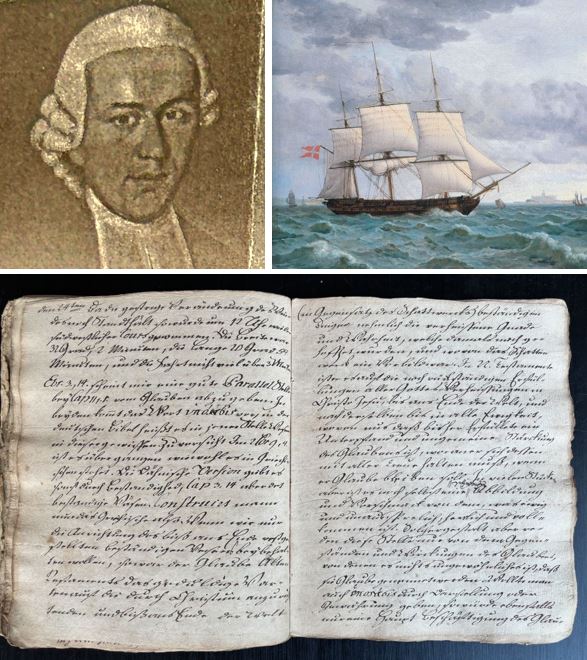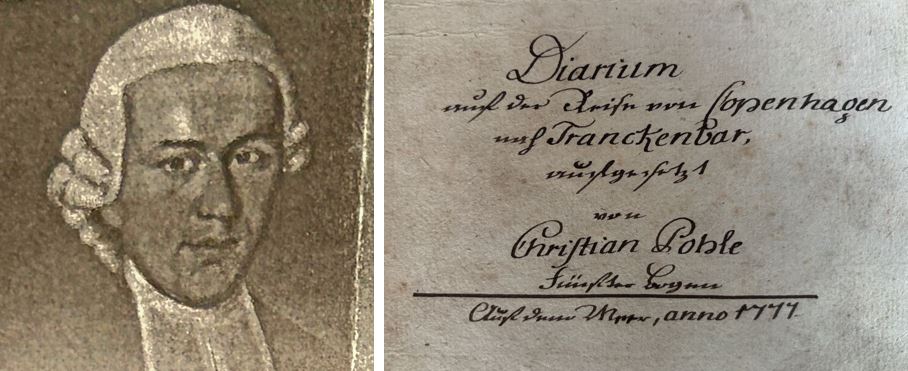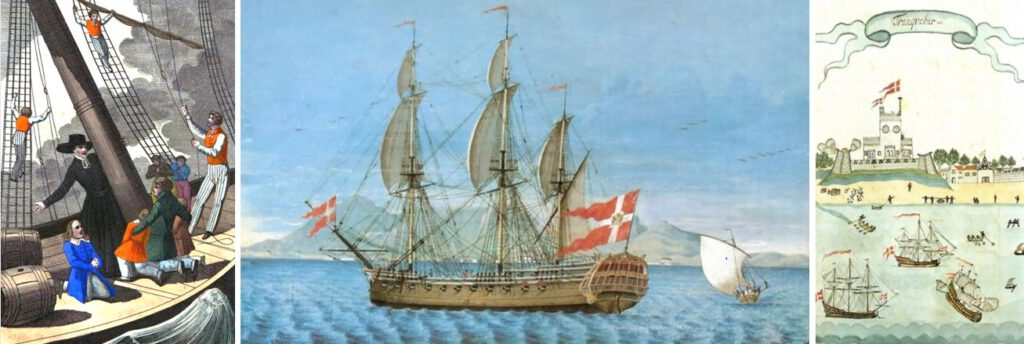
Are you a historian, author, or student interested in an 18th-century project? The transcript of a diary chronicling a sea voyage from Copenhagen to Tranquebar (Tharangambadi) in 1777 might be just the project for you. The trancsript is written in German, and available for free. For more information, application and further procedure, please read on.
The diary of a journey from Copenhagen to Tranquebar was written by Christian Pohle, a missionary of the Danish-Halle Mission. The document is in the possession of history enthusiast Helmut O. He inherited it through the family of his wife, who is a descendant of Christian Pohle. Fascinated by the diary, he transcribed it decades ago, producing about 300 typewritten pages.
Outline of the content
From humble beginnings as a shepherd’s son, Christian Pohle became a missionary educated in natural philosophy and fluent in multiple languages. Aged 32, he departed Copenhagen on 21 December 1776 to embark on what would become the adventure of a lifetime. Unbeknownst to him, he would spend a remarkable 41 years in East India, never returning to his homeland.
Life on board was fraught with dangers but equally rich in adventures for one with a positive outlook. Christian’s diary immerses us in the world of 18th-century seafaring from the perspective of a privileged passenger. Through his writings, we glimpse the daily life on board: accidents, storms, tales of an alleged ghost, sickness, carnival celebrations, a line-crossing ceremony, and death. We observe the weather, track the ship’s progress, marvel at sightings of sharks and a whale, and pause in Cape Town before sailing past the Maldives to finally reach East India on 6 June 1777.

Has Christian Pohle’s Diary Been Cited in Other Sources?
Portions of Christian Pohle’s diary were used in 1836, when Johann Christian Karl Förtsch published an edifying book for young readers about the missionary titled Johann Christian Pohle, der Heidenbekehrer in Ostindien. Förtsch, however, heavily edited the original text to make it accessible for children.
Helmut’s transcription is the only complete and largely unaltered version of the diary.

How Typical Was Christian’s Journey to East India?
In 1706, missionaries Bartholomäus Ziegenbalg and Heinrich Plütschau arrived in Tranquebar under the Danish King Frederik IV’s patronage and established the Tranquebar Mission. Between 1706 and 1818, 38 missionaries made the journey from Halle to Tranquebar, with approximately eight to ten stationed there at any given time. After the Napoleonic Wars (1803–1815), the mission, burdened by debt, closed due to a lack of support from the Danish state.
Missionaries of the Danish-English-Halle Mission typically travelled to India on either a British ship from London or a Danish ship from Copenhagen. The journey could take six to twelve months, depending on the destination, weather, and stopovers. Travelling to Tranquebar took roughly six months. Danish ships would typically set sail from Copenhagen in winter, aiming to reach the Indian Ocean by summer to benefit from the summer monsoon.

Dangers of the Voyage
Beginning a voyage in winter was challenging, as North Sea weather was often severe and treacherous, especially around Scotland. Shipwrecks were not uncommon at this early stage. When storms hit, hatches were sealed, and passengers had to endure the turbulent weather in cramped, stifling cabins, doing their best to remain calm.
Death on board was frequent, with 12–20% of the crew often succumbing to various hazards. Ships commonly began with more crew than necessary to account for potential losses. Crew deaths resulted from accidents, illnesses such as typhus or fever, attacks from pirates or enemy vessels, spoiled food and water, and fires. Fire posed a particular risk near the gunpowder magazine, leading to strict rules against inflammable materials on board — a rule sometimes problematic for missionaries of the Danish-English-Halle Mission, who, having a background in natural philosophy, occasionally needed to transport scientific specimens preserved in high-proof alcohol on their journey home.
Illness was the greatest risk to passengers. In the confined spaces of a ship, diseases could spread rapidly, and an abundance of cockroaches exacerbated the risk of infection.
Six Months at Sea – How to Pass the Time
Missionaries often passed the time studying the Bible or practising preaching, praying, and singing with willing passengers, engaging them in edifying discussions. Since foreign language training was not part of a missionary’s preparation, the voyage provided a chance to pick up useful phrases from seasoned passengers familiar with Malabar, Persian, or Tamil. Opportunities to improve in English, Dutch, or Portuguese were also eagerly embraced.
Keeping a diary was a common pastime. Besides documenting daily occurrences, missionaries who had been trained in natural philosophy, such as hydrostatics and hydrology, would be keen to note weather patterns. For this, a good rapport with the captain and crew was essential. Tracking the ship’s progress was typical, and Christian Pohle also took an interest in natural phenomena, such as the mesmerising “Milky seas effect”—a visible nighttime glow on the water that he admired on multiple occasions in the Indian Ocean.

Social Interactions on Board
Missionaries of the Danish-English-Halle Mission often disapproved of the rough conduct of common sailors and were easily offended by their humour. Social conventions deemed it improper for missionaries to dine with “lower orders,” although missionaries from other institutions, who worked directly with common people, did not mind. Missionaries of the Danish-English-Halle Mission saw themselves as equals to officers, though friendships with certain lower-ranking crew members of “proper religious feeling” occasionally developed, especially if they could make music together.
Conclusion
Christian Pohle’s journey to East India was emblematic of the period. His diary provides a valuable primary source for historians specialising in South Asian studies, maritime history, travel literature, or religious perspectives of the late 18th century.
Further procedure
If you are genuinely interested in working with this transcript, please email a brief outline of your project. I will then connect you with Helmut, who, at age 95, does not use email. He is happy to provide the transcript for free but requests to be kept informed of any resulting research and findings.
Mail to: anna ( at ) regency-explorer.net

Sources
Förtsch, Johann ChristIan Karl: Johann Christian Pohle, der Heidenbekehrer in Ostindien., Leipzig, 1839, 2. edition
Delfs, Tobias: ‘Die Indienreise: Devianz im Zwischenraum‘; in: Delfs, Tobias: Die Dänisch-Englisch-Hallesche Indienmission des späten 18. Jahrhunderts, Franz Steiner Verlag, 2020, S. 73-87
Jørgen Mikkelsen: Suicide and ship hijacking: Join the Asian Company on a dramatic journey to India in the 1700; at: ScienceNordic: https://www.sciencenordic.com/denmark-history/suicide-and-ship-hijacking-join-the-asian-company-on-a-dramatic-journey-to-india-in-the-1700s/1671370
Related articles
Article by Anna M. Thane, author of the novel
“Von tadellosem Ruf” (http://amzn.to/2TXvrez)

